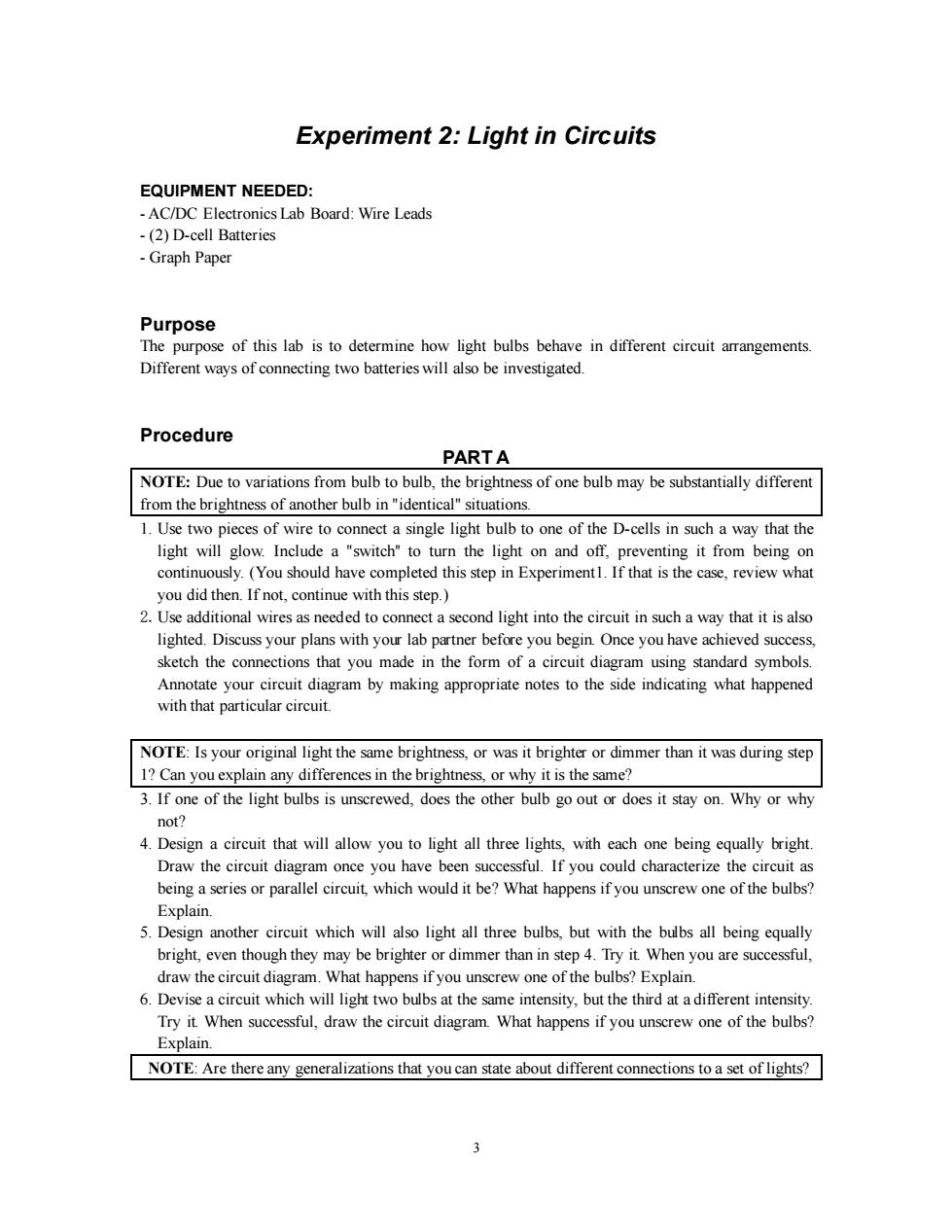正在加载图片...

Experiment 2:Light in Circuits EQUIPMENT NEEDED: -AC/DC Electronics Lab Board:Wire Leads -(2)D-cell Batteries -Graph Paper Purpose The purpose of this lab is to determine how light bulbs behave in different circuit arrangements. Different ways of connecting two batteries will also be investigated. Procedure PARTA NOTE:Due to variations from bulb to bulb,the brightness of one bulb may be substantially different from the brightness of another bulb in"identical"situations. 1.Use two pieces of wire to connect a single light bulb to one of the D-cells in such a way that the light will glow.Include a "switch"to turn the light on and off,preventing it from being on continuously.(You should have completed this step in Experiment1.If that is the case,review what you did then.If not,continue with this step.) 2.Use additional wires as needed to connect a second light into the circuit in such a way that it is also lighted.Discuss your plans with your lab partner before you begin.Once you have achieved success, sketch the connections that you made in the form of a circuit diagram using standard symbols. Annotate your circuit diagram by making appropriate notes to the side indicating what happened with that particular circuit. NOTE:Is your original light the same brightness,or was it brighter or dimmer than it was during step 1?Can you explain any differences in the brightness,or why it is the same? 3.If one of the light bulbs is unscrewed,does the other bulb go out or does it stay on.Why or why not? 4.Design a circuit that will allow you to light all three lights,with each one being equally bright Draw the circuit diagram once you have been successful.If you could characterize the circuit as being a series or parallel circuit,which would it be?What happens if you unscrew one of the bulbs? Explain. 5.Design another circuit which will also light all three bulbs,but with the bulbs all being equally bright,even though they may be brighter or dimmer than in step 4.Try it.When you are successful, draw the circuit diagram.What happens if you unscrew one of the bulbs?Explain. 6.Devise a circuit which will light two bulbs at the same intensity,but the third at a different intensity. Try it.When successful,draw the circuit diagram.What happens if you unscrew one of the bulbs? Explain. NOTE:Are there any generalizations that you can state about different connections to a set of lights?3 Experiment 2: Light in Circuits EQUIPMENT NEEDED: - AC/DC Electronics Lab Board: Wire Leads - (2) D-cell Batteries - Graph Paper Purpose The purpose of this lab is to determine how light bulbs behave in different circuit arrangements. Different ways of connecting two batteries will also be investigated. Procedure PART A NOTE: Due to variations from bulb to bulb, the brightness of one bulb may be substantially different from the brightness of another bulb in "identical" situations. 1. Use two pieces of wire to connect a single light bulb to one of the D-cells in such a way that the light will glow. Include a "switch'' to turn the light on and off, preventing it from being on continuously. (You should have completed this step in Experiment1. If that is the case, review what you did then. If not, continue with this step.) 2.Use additional wires as needed to connect a second light into the circuit in such a way that it is also lighted. Discuss your plans with your lab partner before you begin. Once you have achieved success, sketch the connections that you made in the form of a circuit diagram using standard symbols. Annotate your circuit diagram by making appropriate notes to the side indicating what happened with that particular circuit. NOTE: Is your original light the same brightness, or was it brighter or dimmer than it was during step 1? Can you explain any differences in the brightness, or why it is the same? 3. If one of the light bulbs is unscrewed, does the other bulb go out or does it stay on. Why or why not? 4. Design a circuit that will allow you to light all three lights, with each one being equally bright. Draw the circuit diagram once you have been successful. If you could characterize the circuit as being a series or parallel circuit, which would it be? What happens if you unscrew one of the bulbs? Explain. 5. Design another circuit which will also light all three bulbs, but with the bulbs all being equally bright, even though they may be brighter or dimmer than in step 4. Try it. When you are successful, draw the circuit diagram. What happens if you unscrew one of the bulbs? Explain. 6. Devise a circuit which will light two bulbs at the same intensity, but the third at a different intensity. Try it. When successful, draw the circuit diagram. What happens if you unscrew one of the bulbs? Explain. NOTE: Are there any generalizations that you can state about different connections to a set of lights?